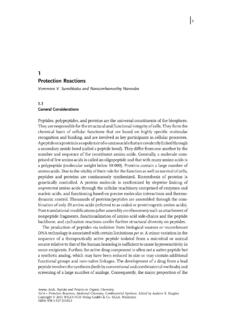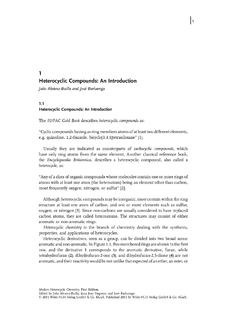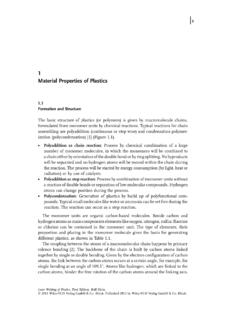Transcription of 1 Water Resources: Quantity and Quality - Wiley-VCH
1 J1. 1. Water Resources: Quantity and Quality Water pollution, together with loss of biodiversity, climate change, energy and socio- economic issues, is one of the main threats and challenges humanity faces today. Human activities and human-related substances and wastes introduced into rivers, lakes, groundwater aquifers and the oceans modify the environmental Water Quality and make huge quantities of Water unsuitable for various uses. This is the case not only for human-related uses such as drinking, bathing, agricultural irrigation and industrial production but also for terrestrial and aquatic ecosystems for which clean, fresh Water is a prerequisite for life.
2 Water pollution is a serious problem for human health and the environment. The extent of the problem has been con rmed by many reports from UN organisations and related statistics. For example the Global Environment Outlook report (2000). produced by the United Nations Environment Programme (UNEP) included the following statistics: . Already one person in ve has no access to safe drinking Water .. Polluted Water affects the health of billion people every year, and contributes to the death of 15 million children less than 5 years of age every year.
3 Three million people die every year from diarrhoeal diseases (such as cholera and dysentery) caused by contaminated Water .. Vector-borne diseases, such as malaria, kill another million people per year, with inadequate Water management a key cause of such diseases. Water pollution contributes to the so-called global Water crisis , because it reduces the available amount of freshwater resources for both people and ecosystems. Freshwater scarcity is already a reality in many parts of the world, not only in developing countries like India, China and many African countries, but also in countries and regions traditionally considered as Water rich, such as the USA and Europe.
4 The United Nations (UN) predicts that two-thirds of the world s population will live in Water -scarce regions by 2025. The increase in Water demand, together with the increase in population in many parts of the world, but mainly the over use of Water in areas like agriculture, together with Water pollution and climate change are the main driving forces behind this phenomenon. Risk Analysis of Water Pollution: Second, Revised and Expanded Edition. Jacques Ganoulis Copyright 2009 Wiley-VCH Verlag GmbH & Co. KGaA, Weinheim ISBN: 978-3-527-32173-5.
5 J 1 Water Resources: Quantity and Quality 2. The Quality of Water resources and aquatic ecosystem preservation are very much related to the design and operation of hydraulic engineering structures, such as dams, reservoirs and river levees. Until now the design of these structures has paid far greater attention to cost, bene t and safety than to issues of environmental impact. Technical projects such as wastewater treatment plants, management of waste disposal and remediation of contaminated sites, which aim to treat wastewaters and therefore improve Water Quality , also produce various environmental hazards and risks.
6 To face real situations of Water resources pollution, the ef cient application of an environmental impact assessment, including data acquisition, risk analysis and examination of institutional aspects of Water resources management, is of crucial importance. In this book the term Water resources covers fresh surface Water and groundwater, as well as coastal Water resources. Many new techniques for risk assessment and management have been developed recently both in the USA and Europe (Duckstein and Plate, 1987; Ganoulis, 1991c.)
7 Haimes et al., 1992; Morel and Linkov, 2006; Hlavinek et al., 2008). These techniques aim to quantify the risks arising from the various uses of Water , for example urban Water supply, irrigation and industrial processes. However, few of these develop- ments have ltered into academic curricula, and even fewer into engineering practice. The main objective of this book is to present, in a uni ed framework, methods and techniques of risk and reliability analysis for evaluating the impact on environmental Water Quality from different Water uses, wastewater disposal and Water resources management planning.
8 Risk and reliability analysis has also been used in elds other than engineering, for example in social, economic and health sciences. Risks have been analysed within these disciplines in relation to public policy, administration, nancing or public health. Public risk perception, social behaviour and attitudes under risk, risk costs and exposure assessment are some of the major topics of study. In this book environmental risk and reliability analysis is discussed, as applicable speci cally to Water pollution in the natural environment.
9 Risk and reliability analysis may also provide a general methodology for the assessment of the safety of Water - related engineering projects. In Water pollution problems, risk is related to various uncertainties in the fate of pollutants. Thus, risk and reliability assessment of Water pollution is a useful tool to quantify these uncertainties and evaluate their effect on Water resources. In this respect, the important technical aspects are the management of hydrosystems (rivers, lakes, aquifers and coastal areas) taking into account Water Quality and environmental impacts, the design of environmental amenities, the management of waste disposal, the optimum operation of wastewater treatment plants and the remediation of contaminated sites.
10 Important features covered in this book are: . Uncertainty Analysis of Water Quantity and Quality .. stochastic Simulation of Hydrosystems: model selection, Water Quantity and Quality assessment and changes in Water Quality due to possible climate change in coastal waters, risk of groundwater and river pollution.. Application of Fuzzy Set Theory in Engineering Risk Analysis. Water Pollution and Risk Analysis j3.. Decision Theory under Uncertainty: risk management, risk cost trade-offs.. Case Studies. Environmental Water pollution could lead to public health hazards (risk to human health), deterioration of Water Quality and damage to ecosystems (environmental risk) or may cause economic consequences (economic risk).









